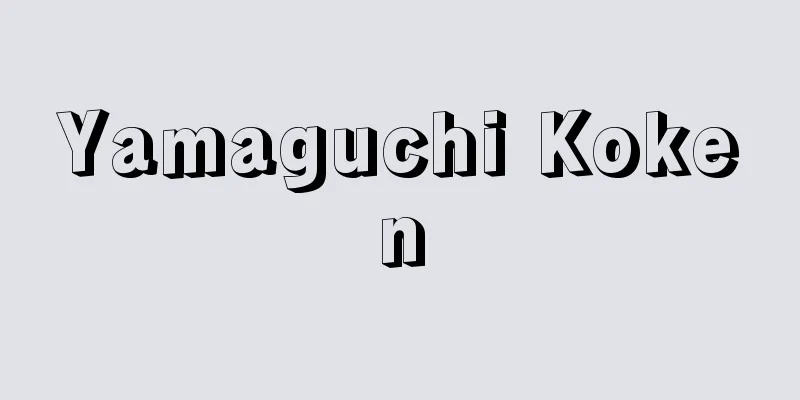Sword Hunting

|
The Toyotomi government's class policy, which sought to limit the right to bear arms to the samurai class, is also known as Katanakari, Katanakari, Bugugari (Bugu-gari), Dogukari, Aratame, and Katanatazune. As an edict to disarm the general public that was implemented throughout early modern society, it is known, along with national isolation, as demonstrating a unique characteristic of Japanese history that is unparalleled in the history of the world. However, it is not true that civilian weapons were eradicated, and its essence is thought to have been a measure to establish a class system that sought to limit and officially recognize the use of swords, which were originally a status mark for independent members of society, to samurai only. An early example of this was the "sword hunting" carried out by Shibata Katsuie in Echizen Province (Fukui Prefecture) in 1576 (Tensho 4), but the details of this are unknown. The Toyotomi Sword Hunting Order first appeared in April 1585 as part of the occupation policy of Kii Province (Wakayama Prefecture), in an order that said, "From now on, peasants in all areas are to cease using bows and arrows, spears, guns, and swords, and in return, they should learn to use hoes and other farming tools and devote themselves to farming," and became the prototype of the Sword Hunting Order. The targets of the ban ranged from farmers to monks at large temples such as Mount Koya, Negoro-ji Temple, and Tonomine, and the ban on weapons was enforced. In July of the following year, the ban on swords was also imposed in farming villages in Yamashiro Province (Kyoto Prefecture) and in the territory of Shoren-in Temple. The nationwide sword hunt edict (three articles, Hideyoshi's red seal letter) was issued in July 1588. The main text of the edict is the first, which begins with "It is strictly forbidden for the peasants in all provinces to possess swords, swords, arrows, spears, tetsuwa and other weapons," and ends with "All weapons must be collected and presented to the peasants." However, the edict goes on to justify the confiscation of weapons by persuading the peasants that the weapons would be used as nails and clamps to build a new Great Buddha (Hokoji Temple) in order to pray for their happiness in this life and the next (Article 2). At the same time, following the previous Kishu sword hunt edict, the edict actively points out the nature of the peasant status, stating, "If the peasants possess even farm tools and devote themselves to farming, they will live long for generations to come" (Article 3), and is characterized as a status policy in that it is clearly targeted exclusively at peasants. The implementation of this was to have the daimyo order all the adult peasants in each village in his territory to sign a pledge, focusing on weapons, especially swords and wakizashi, and then to have them handed over to Hideyoshi's magistrate. This was widely implemented over several years from Mutsu to Satsuma (Kagoshima Prefecture), and it is believed that weapons were also procured for the invasion of Korea. 40 days after the issuance of the order, Hideyoshi's magistrate issued a request for weapons for Enuma County in Kaga (Ishikawa Prefecture), which included 1,073 swords, 1,540 wakizashi, 160 yari, 500 kogai, and 700 small knives. However, there were many exceptions to the implementation of the sword hunt. Certain townspeople were allowed to own swords, saying, "Those townspeople who do not cultivate rice fields should be given swords and wakizashi from now on," and they were allowed to keep them as ritual implements rather than weapons, saying, "They should only be sent out during religious ceremonies," and they were allowed to keep them as ritual implements rather than weapons, saying, "As long as there are many deer and wild boars, ten spears should be allowed to be kept," and they were licensed for each village as agricultural tools for exterminating pests, and were also approved depending on the public order situation. In other words, while the system took the form of a license system by the daimyo, the possession of many weapons, including swords, wakizashi, and guns, was officially recognized among the rural villages and common people under various pretexts. Thus, the nature of the Sword Hunting Order as a social status law is well illustrated by the way in which a broad range of weapon licensing systems, centered on carrying swords, were developed based on a general prohibition on the possession of weapons by the oppressed classes, and then based on status and purpose. However, the use of weapons by ordinary people as a means of resolving disputes, as was the case in the Middle Ages, was strictly prohibited by the Toyotomi government's Fighting Cessation Order, which preceded the Sword Hunting Order. What was inherited in the early modern period was not the policy of eradicating weapons used by private citizens as is commonly said, but the aforementioned weapon licensing system and Fighting Cessation Order, and up until the first half of the 17th century, there were restrictions on the length, color of the scabbard, and shape of the tsuba (guard guard) of swords and wakizashi used by peasants and townspeople, but there is no evidence that the possession itself was prohibited. [Fujiki Hisashi] "Japanese Cultural History IV" by Tsuji Zennosuke (1950, Shunjusha)" ▽ "Kuwata Tadachika, "Sword Hunt" (included in Toyotomi Hideyoshi Studies, 1975, Kadokawa Shoten)" ▽ "Tsukamoto Manabu, "Politics Surrounding Living Things" (1983, Heibonsha)" ▽ "Fujiki Hisashi, "The Unearthing of Toyotomi's Order to Stop Fighting" (included in UP No. 137, 1984, University of Tokyo Press)" ©Shogakukan "> Sword Hunt (explanation) Source: Shogakukan Encyclopedia Nipponica About Encyclopedia Nipponica Information | Legend |
|
武装権を武士身分に限定しようとする豊臣(とよとみ)政権の身分政策。刀かり、刀駈(かたなかり)、武具狩(武具駈)、道具かり、武具改(あらため)、刀尋(かたなたずね)ともいう。近世社会を通じて貫徹した民衆の武装解除令として、鎖国とともに、世界の歴史にも例のない日本史の特質を示すものとして知られてきたが、民間の武器が絶滅された事実はなく、その本質は、もともと自立した社会成員の身分標識であった刀の使用を武士のみに限定公認しようとする、身分制の確立策にあったとみられる。 その早い例としては、1576年(天正4)に柴田勝家(しばたかついえ)が越前国(えちぜんのくに)(福井県)で行った「刀さらへ」があるが、その実態は未詳である。豊臣刀狩令の初見は、1585年4月に紀伊国(和歌山県)の占領政策の一環として出された「在々百姓等、自今以後、弓箭(ゆみや)・鑓(やり)・鉄砲・腰刀等停止(ちょうじ)せしめおわんぬ、しかる上は、鋤鍬(すきくわ)等農具をたしなみ、耕作をもっぱらにすべきものなり」という指令であり、刀狩令の原型となった。その対象は、農民から、高野山(こうやさん)、根来寺(ねごろじ)、多武峯(とうのみね)など大寺院の僧侶(そうりょ)にも及び、「兵具ヲカル」ことが強行された。翌年7月には山城国(やましろのくに)(京都府)の農村や青蓮院門跡(しょうれんいんもんぜき)領にも「刀かり」が行われた。 全国にわたる刀狩令(三か条の条書、秀吉朱印状)が出されたのは1588年7月である。その主文は「諸国百姓等、かたな・わきざし・ゆみ・やり・てつはう、その外武具のたぐひ所持候こと、堅く御停止候」に始まり「みぎ武具悉(ことごと)くとりあつめ進上いたすべきこと」で終わる第一条であるが、さらに、取り上げた武器は百姓の今世・来世の幸福を祈って新たな大仏(方広寺)建立のくぎ・かすがいとして活用する、と説得して、武器の没収を正当化し(第二条)、あわせて、先の紀州刀狩令を受けて、「百姓は農具さへもち、耕作を専らに仕り候へば、子々孫々までも長久に候」(第三条)と農民身分のあり方を積極的に指し示すなど、もっぱら百姓を対象として明記しているところに身分政策としての特徴がある。その実施は、大名に命じて、その領域単位に、村ごとに「おとな百姓共にせいし(誓約書)をさせ」て武器とくに刀・脇差(わきざし)を重点的に差し出させ、それをまとめて秀吉の奉行(ぶぎょう)に提出させるという方式で、数年間にわたって、陸奥(むつ)から薩摩(さつま)(鹿児島県)まで広く実施され、朝鮮侵略のための武器調達も行われたとみられる。発令の40日後、秀吉の奉行の出した加賀(石川県)江沼郡の武具請取状の内訳は、刀1073腰、脇差1540腰、鑓160本、こうがい500本、小刀700に上った。しかし、刀狩の実施には多くの例外措置が講じられていた。「町人、田畠作り申さず候者には、人指しにて、以来は刀・わきざし御もたせあるべき」として、特定の町人には刀の所持を許し、また「神事の時ばかり、かし遣わされ候様に」といい、武器ではなく祭器として保管することを許可したり、「しし(鹿・猪)おおく候あいだ、則(すなわち)やり十本ゆるし置」といい、害獣駆除の農具として村ごとに免許したり、治安の状況によっても認可した。すなわち、大名による免許制の形をとりながら、さまざまの名目で、農村や民衆の間に刀や脇指・鉄砲をはじめ多数の武器の保有が公認された。 このように、原則として被支配階級の武器所持を禁止したうえで展開される、帯刀を中心とした広範な身分別・用途別の武器所持の免許制のあり方こそは、身分法令としての刀狩令の特質をよく現している。ただし、中世のように民衆が武器を紛争解決の手段として自ら使用することは、刀狩令に先行する豊臣政権の喧嘩(けんか)停止令によって厳禁された。近世に継承されたのも、普通いわれるような民間の武器絶滅策ではなく、前述の武器免許制と喧嘩停止令であり、17世紀前半までは、百姓・町人の刀や脇差についても、その長さ、鞘(さや)の色、鍔(つば)の形などの規制は行われても、所持そのものが禁止された形跡は認められない。 [藤木久志] 『辻善之助著『日本文化史Ⅳ』(1950・春秋社)』▽『桑田忠親「刀狩」(『豊臣秀吉研究』所収・1975・角川書店)』▽『塚本学著『生類をめぐる政治』(1983・平凡社)』▽『藤木久志「豊臣喧嘩停止令の発掘」(『UP』137号所収・1984・東京大学出版会)』 ©Shogakukan"> 刀狩(釈文) 出典 小学館 日本大百科全書(ニッポニカ)日本大百科全書(ニッポニカ)について 情報 | 凡例 |
Recommend
Jingasauni - Jingasauni
This sea urchin is a marine animal that belongs t...
Stanhope, C.
…With the invention of this machine, the pressure...
Akadama - Akadama
This refers to reddish-brown jasper that is used ...
Ryuzan Stone
The name of the stone material. Tuff from Hyogo Pr...
specific birth rate
...However, in reality, the denominator P does no...
Kissing Gourami - Kissing Gourami
… 【kinds】 Next, let's look at the characteris...
Iwakura - Iwakura
The name "iwakura" appears in the Kojik...
Uji Ajiro
...The fishermen have been providing sacrifices t...
Kant-Laplace's Nebular Theory
→Nebula theory Source : Heibonsha Encyclopedia Abo...
Elista - Elista (English spelling) Элиста/Elista
Located in the southwest of the Russian Federatio...
Wilting - Wilting
This phenomenon occurs when the amount of water lo...
Cryptolestes ferrugineus
… Flat grain beetles are 2-5mm long. Many species...
Sodium cyclamate
…Sodium cyclohexylsulfamate (also called sodium c...
Divorce by mutual consent - Kyogirikontodoke
…(2) Problems with the current law The fact that ...
AGIL diagram - AGIL diagram
…The theoretical characteristics of social system...









